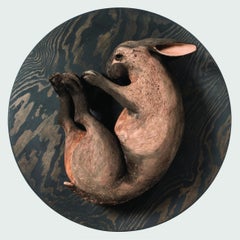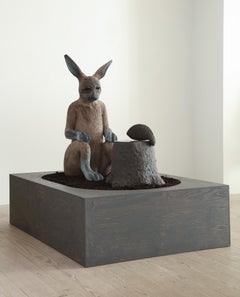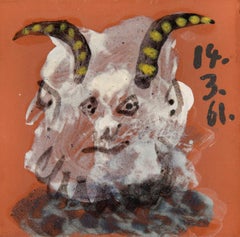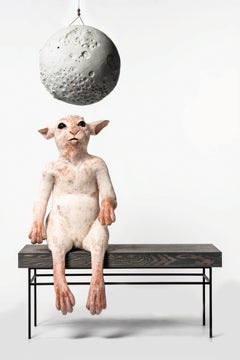Margit Brundin Art
4
1
1
2
Overall Height
to
Overall Width
to
4
2
1
1
1
1
1
1
1
1
4
4
6,935
3,285
2,514
1,213
4
Artist: Margit Brundin
Back to Earth
By Margit Brundin
Located in New York, NY
Margit Brundin, Swedish, (b. 1981, Ängelholm, Sweden)
A collection of works by Swedish ceramic artist Margit Brundin, of human-scale hares created for this exhibition, "A Place Behi...
Category
21st Century and Contemporary Margit Brundin Art
Materials
Ceramic
Strömma ner på Rygg
By Margit Brundin
Located in New York, NY
Margit Brundin, Swedish, (b. 1981, Ängelholm, Sweden)
A collection of works by Swedish ceramic artist Margit Brundin, of human-scale hares created for this exhibition, "A Place Behi...
Category
21st Century and Contemporary Margit Brundin Art
Materials
Ceramic
Mirror Mirror
By Margit Brundin
Located in New York, NY
A collection of works by Swedish ceramic artist Margit Brundin, of human-scale hares created for this exhibition, A Place Behind the Oak Tree, transforms our gallery. Installed among...
Category
21st Century and Contemporary Margit Brundin Art
Materials
Ceramic
Watching You
By Margit Brundin
Located in New York, NY
A collection of works by Swedish ceramic artist Margit Brundin, of human-scale hares created for this exhibition, "A Place Behind the Oak Tree", transforms our gallery. Installed amo...
Category
21st Century and Contemporary Margit Brundin Art
Materials
Ceramic
Related Items
Tête de Faune, Picasso, Unique work, 1960's, Terracotta, Tiles, Design, Sculptur
By Pablo Picasso
Located in Geneva, CH
Tête de Faune, Picasso, Unique work, 1960's, Terracotta, Tiles, Design, Sculptur
Tête de faune
Unique work
14.03.1961
Painted and glazed terracotta tile...
Category
1960s Post-War Margit Brundin Art
Materials
Terracotta
H 5.91 in W 5.91 in D 0.6 in
Roman 18th century terracotta model for the sculpture of San Camillo de Lellis
Located in London, GB
This remarkably fluid terracotta bozetto was made in preparation for Pietro Pacilli’s most important public commission, a large-scale marble statue of San Camillo de Lellis for the nave of St Peter’s Basilica in Rome. Expressively modelled, this terracotta sculpture is a rare and significant work made by a major Roman sculptor at a transformative moment of European sculpture. Pacilli began his working life on the great Baroque decorative projects initiated in the seventeenth century, but he found success as a restorer of ancient sculpture working to finish antiquities for a tourist market, becoming an important figure in the emergence of an archaeologically minded Neoclassicism. Pacilli trained Vincenzo Pacetti and provided important decorative work for the Museo Pio-Clementino, at the same time he is recorded restoring some of the most celebrated antiquities excavated and exported during the period.
Pacilli was born into a family of Roman craftsmen, his father Carlo was a wood carver, and Pacilli is recorded working with him on the Corsini Chapel in San Giovanni Laternao as early as 1735. In 1738 his terracotta model of Joseph and Potiphar’s Wife won the first prize in the second class of the sculpture concorso at the Accademia di San Luca, this is particularly notable as Bartolomeo Cavaceppi came third. He worked as a carver and stuccoist completing works for the churches of San Marco and SS. Trinita dei Domeniciani Spagnoli. Pacilli operated as a sculptor and restorer of antiquities from his studio at the top of the Spanish Steps, close to Santa Trinita dei Monti, where he is listed as a potential vendor to the Museo Pio-Clementino in 1770.
In 1763 Pacilli completed a silver figure of San Venanzio for the treasury of San Venanzio. He is recorded as Pacetti’s first master and it was evidently through Pacilli that he began to acquire his facility as a restorer of ancient sculpture. Pacilli, at his studio ‘poco prima dell’Arco della Regina alla Trinita dei Monti,’ exercised, what the nineteenth-century scholar, Adolf Michaelis called ‘rejuvenating arts’ on several important pieces of classical sculpture, including in 1760 the group of a Satyr with a Flute for the natural brother of George III, General Wallmoden, Hanovarian minister at Vienna. In 1765, Dallaway and Michaelis record that Pacilli was responsible for the restorations, including the addition of a new head, to the Barberini Venus which he had acquired from Gavin Hamilton. The Venus was then sold to Thomas Jenkins, who in turn passed it on to William Weddell at Newby Hall. In 1767 Pacilli exported a series of ancient busts ‘al naturale’ including portraits of Antinous, Julius Ceaser and Marus Aurelius, also a statue of a Muse and a Venus. As early as 1756 Pacilli seems to have been operating as an antiquarian, helping to disperse the collection of the Villa Borrioni. Pacilli supplied sculpture to notable British collectors, including Charles Townley, who on his first trip to Italy purchased the Palazzo Giustiniani statue of Hecate from Pacilli. Pacilli was involved with the Museo Pio Clementino from its conception, supplying busts of Julius Ceaser and a Roman Woman as well as completing stucco putti surmounting the arms of Pope Bendedict XIV to signal the entrance to the new Museo Critiano.
In 1750 Il Diario Ordinario del Chracas announced that Pacilli had begun work on a sculpture of San Camillo de Lellis for St Peter’s. Camillo de Lellis founded his congregation, the Camillians, with their distinctive red felt crosses stitched on black habits in 1591. Having served as a soldier in the Venetian army, Camillo de Lellis became a novitiate of the Capuchin friars, he moved to Rome and established a religious community for the purpose of caring for the sick. In 1586 Pope Sixtus V formerly recognised the Camillians and assigned them to the Church of Santa Maria Maddalena in Rome. Camillo de Lellis died in 1614 and was entombed at Santa Maria Maddalena, he was canonised by Benedict XIV on June 26, 1746. It was an occasion that prompted the Camillians to make a number of significant artistic commissions, including two canvases by Pierre Subleyras showing episodes from San Camillo’s life which they presented to Benedict XIV. In 1750 Pacilli was commissioned to fill one of the large niches on the north wall of the nave with a sculpture of San Camillo.
The present terracotta bozetto presumably had two important functions, to enable Pacilli to work out his ideas for the finished sculpture and at the same time to show his design to the various commissioning bodies. In this case it would have been Cardinal Alessandro Albani and Monsignor Giovan Francesco Olivieri, the ‘economo’ or treasurer of the fabric of St Peter’s. Previously unrecorded, this terracotta relates to a smaller, less finished model which has recently been identified as being Pacilli’s first idea for his statue of San Camillo. Preserved in Palazzo Venezia, in Rome, the terracotta shows San Camillo with his left hand clutching his vestments to his breast; the pose and action more deliberate and contained than the finished sculpture. In producing the present terracotta Pacilli has expanded and energised the figure. San Camillo is shown with his left hand extended, his head turned to the right, apparently in an attempt to look east down the nave of St Peter’s. The model shows Pacilli experimenting with San Camillo’s costume; prominently on his breast is the red cross of his order, whilst a sense of animation is injected into the figure through the billowing cloak which is pulled across the saint’s projecting right leg. The power of the restrained, axial contrapposto of bent right leg and outstretched left arm, is diminished in the final sculpture where a baroque fussiness is introduced to the drapery. What Pacilli’s terracotta demonstrates, is that he conceived the figure of San Camillo very much in line with the immediate tradition of depicting single figures in St Peter’s; the rhetorical gesture of dynamic saint, arm outstretched, book in hand, head pointed upwards was perhaps borrowed from Camillo Rusconi’s 1733 sculpture of St. Ignatius...
Category
18th Century Baroque Margit Brundin Art
Materials
Terracotta
Hibou aux ailes déployées (Owl with spread wings), 1957
By Pablo Picasso
Located in Palo Alto, CA
Created in 1975, this madoura turned round dish of red earthenware clay, engobe decoration in black and knife engraving is from the edition of 200 and stamped with the 'MADOURA PLEIN FEU' and 'EDITION PICASSO' pottery stamps on the back.
Pablo Picasso ceramic Hibou aux ailes déployées (Owl with spread wings), 1957 A.R. 397 features a smiling owl with wings opening above its head. The owl sits on a thin branch that spans the lower length of the plate, extending the scene beyond the bounds of the ceramic. Beautiful, bushy feathers fan out. Picasso uses...
Category
1950s Modern Margit Brundin Art
Materials
Ceramic
Tête de chèvre de profil (Goat's Head in Profile)
By Pablo Picasso
Located in Palo Alto, CA
Created in 1952, Tête de chèvre de profil (Goat’s Head in Profile) 1952 A.R. 145, is a Madoura oblong dish of white earthenware clay with deco...
Category
1950s Modern Margit Brundin Art
Materials
Ceramic
“Adam and Eve”
Located in Southampton, NY
Very rare Art Deco three dimensional terracotta sculpture of Adam and Eve by the Austrian artist, Virgil Rainer. Hand painted by the artist. Signed bott...
Category
1920s Art Deco Margit Brundin Art
Materials
Terracotta, Plaster
Sancai-Glazed Horse with Cut Fur Blanket
Located in Palm Desert, CA
A Chinese, Tang Dynasty, Sancai-glazed, three colors of brown, green and creamy, sculpture of a horse with a cut fur blanket. This Chinese, Tang Dynasty (618-907 AD), glazed earthenw...
Category
15th Century and Earlier Margit Brundin Art
Materials
Earthenware, Glaze
Medusa and Andromeda
By Magdeburger Kunstwerkstatten Reps and Trinte
Located in West Hollywood, CA
Medusa and Andromeda, is a unique three dimensional terra cotta sculpture/vase, created by the German firm Magdeburger Kunstwerkstatten, Reps and Trinte, a studio that specialized in fine works in terra cotta.
This monumental piece depicts the entire story of the Medusa, who holds Andromeda captive by chaining her to rocks in the ocean. You can see the chains at her wrists and ankles. Medusa charges the Leviathan (dragon) as guard over the captive Andromeda. Andromeda was rescued by her future husband Perseus who killed the dragon and saved his future bride.
This is one of the most unique works of its kind that has been seen to date. It was probably a sculpture/vase designed and created for presentation at one of the yearly Salon exhibitions in Europe. We have consulted experts in European ceramics...
Category
Early 1900s Margit Brundin Art
Materials
Terracotta
Visage noir Moucheté, Picasso, Plate, Portrait, Naif, Multiples, Earthenware
By Pablo Picasso
Located in Geneva, CH
Visage noir Moucheté, Picasso, Plate, Portrait, Naif, Multiples, Earthenware
Visage noir moucheté
Ed. 39/200 pcs
1948
white earthenware clay, decoration in engobes under glaze
31 x ...
Category
1940s Post-War Margit Brundin Art
Materials
Ceramic, Clay, Earthenware
Petite tête, profil gauche (Small Head, Left Profile), A.R. 535
By Pablo Picasso
Located in Palo Alto, CA
Created in 1965, this terre de faïence sculpture with white slip is inscribed on the sculptural base with the atelier stamps ‘EDITION PICASSO’ and ‘MADOURA...
Category
1960s Modern Margit Brundin Art
Materials
Slip, Faience
Tête Solaire, Pablo Picasso, Unique Ceramic, 1950's, Earthenware, Design, Tile
By Pablo Picasso
Located in Geneva, CH
Tête Solaire, Pablo Picasso, Unique Ceramic, 1950's, Earthenware, Design, Tile
Tête solaire II
Unique work
27.01.1956
Large white earthenware tile, green stripes on white enamel on ...
Category
1950s Post-War Margit Brundin Art
Materials
Ceramic, Earthenware
Serpent
By Ross Redmon
Located in Kansas City, MO
Ross Redmon
Title: Serpent
Ceramic, Post Fire Surfaces
Year: 2014
Size: 84 x 26 x 19 inches
Signed
COA provided
Ross Redmon is a Kansas City based artist, originally from Greer, So...
Category
2010s Contemporary Margit Brundin Art
Materials
Ceramic, Paint
Femmes Fleurs (Women Pitcher)
By Pablo Picasso
Located in Palo Alto, CA
Pablo Picasso Ceramic Femmes Fleurs (Women Pitcher), 1948 A.R. 50 is an elegant turned pitcher highlights the graceful form of the female nude. C...
Category
1940s Modern Margit Brundin Art
Materials
Earthenware, Ceramic
Previously Available Items
Stargazer
By Margit Brundin
Located in New York, NY
Margit Brundin, Swedish, (b. 1981, Ängelholm, Sweden)
A collection of works by Swedish ceramic artist Margit Brundin, of human-scale hares created for this exhibition, "A Place Behi...
Category
21st Century and Contemporary Margit Brundin Art
Materials
Ceramic
Falla i Gränslandet
By Margit Brundin
Located in New York, NY
A collection of works by Swedish ceramic artist Margit Brundin, of human-scale hares created for this exhibition, A Place Behind the Oak Tree, transforms Dienst + Dotter Antikviteter...
Category
21st Century and Contemporary Margit Brundin Art
Materials
Ceramic
At the End of the Path
By Margit Brundin
Located in New York, NY
A collection of works by Swedish ceramic artist Margit Brundin, of human-scale hares created for this exhibition, A Place Behind the Oak Tree, transforms our gallery. Installed among...
Category
21st Century and Contemporary Margit Brundin Art
Materials
Ceramic
Sit Beside Me
By Margit Brundin
Located in New York, NY
A collection of works by Swedish ceramic artist Margit Brundin, of human-scale hares created for this exhibition, A Place Behind the Oak Tree, transforms our gallery. Installed among...
Category
21st Century and Contemporary Margit Brundin Art
Materials
Ceramic
Silent Coversation
By Margit Brundin
Located in New York, NY
A collection of works by Swedish ceramic artist Margit Brundin, of human-scale hares created for this exhibition, A Place Behind the Oak Tree, transforms Dienst + Dotter Antikviteter...
Category
21st Century and Contemporary Margit Brundin Art
Materials
Ceramic
Margit Brundin art for sale on 1stDibs.
Find a wide variety of authentic Margit Brundin art available for sale on 1stDibs. You can also browse by medium to find art by Margit Brundin in ceramic and more. Not every interior allows for large Margit Brundin art, so small editions measuring 17 inches across are available. Customers who are interested in this artist might also find the work of Gregory Green, Laurence Perratzi, and Louis Sclafani.







